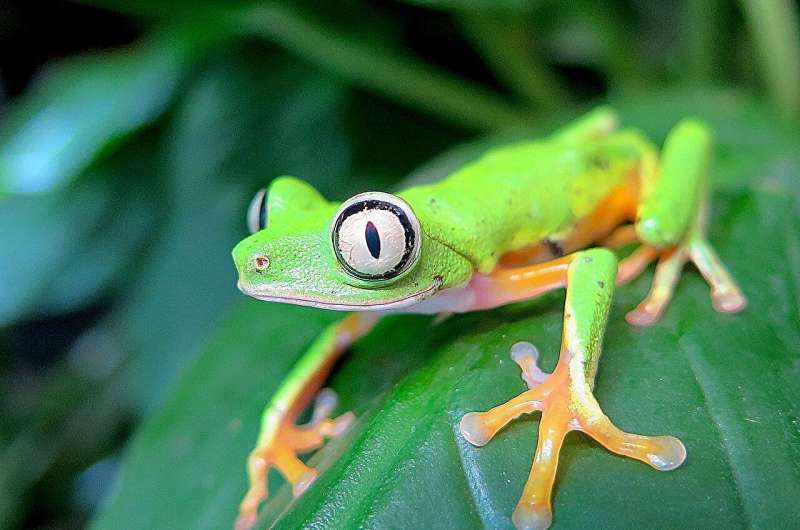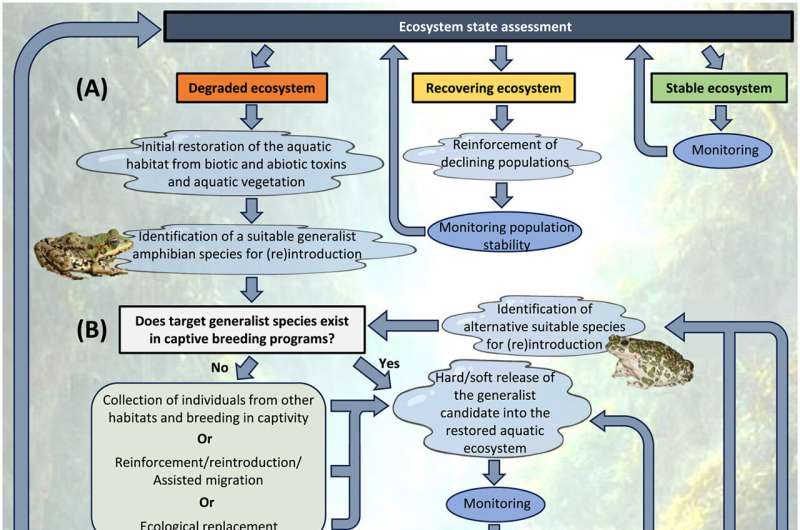This article has been reviewed according to Science X's editorial process and policies. Editors have highlighted the following attributes while ensuring the content's credibility:
fact-checked
peer-reviewed publication
trusted source
proofread
Rewilding amphibians: Protecting endangered species to restore ecosystems

In a recent paper published in Biological Conservation, iDiv researchers suggest that given amphibians' ability to act as "canaries in the coal mine" for aquatic environments, they should be reintroduced or rewilded. Rewilding would not only help protect these endangered species but simultaneously promote ecological stability.
Amphibians, such as salamanders, frogs, and newts, are the most threatened of all vertebrates, with over 40% of all species worldwide at risk of extinction. They are also unique in providing early information about aquatic ecosystems' ecological state due to their extremely sensitive and permeable skins.
According to the researchers, the presence and overall health of amphibians as so-called bioindicators is important for setting more ambitious conservation objectives in the future, such as reintroducing mammals.
The researchers also present a reintroduction scheme outlining steps to establish a stable ecosystem using more robust species, like amphibians, with the goal of restoring ecological interactions. Restoring ecological interactions can help conservationists reintroduce other, more specialized species as aquatic ecosystems recover.

The state of the world's amphibians
Amphibian declines and extinctions are attributed to multiple, complex factors, including habitat degradation, climate change, and, most critically, infectious diseases such as Batrachochytrium dendrobatidis.
Addressing these extinction drivers makes it possible to improve the effectiveness of conservation efforts to protect amphibians. However, to date, most conservation programs have yet to effectively take action to support this vanishing group of species. Alternative conservation strategies are needed to protect and promote amphibians in different regions.
Rewilding is an increasingly popular conservation strategy that reintroduces a native species into an environment where it was once found but is no longer present. Beavers, moose, and wolves are some species that have been effectively reintroduced in Europe in recent years.
The researchers argue that incorporating amphibians in rewilding projects can help conserve endangered species, such as tropical frogs, and restore ecosystem functionality for other organisms.
Amphibians for rewilding
With their paper, the researchers seek to raise awareness of the benefits of amphibians in rewilding projects. They highlight that amphibians can serve a dual purpose as bioindicators for ecosystem health and as key species in an ecosystem's food webs.
The researcher's well-planned reintroduction scheme for amphibians outlines steps to establish a stable ecosystem using more robust species to restore ecological interactions, which can also be applied to other groups in various regions and help promote rewilding as a leading conservation strategy worldwide.
In general, the steps are divided into three stages: assessing the state of the ecosystem, choosing the most ideal candidate for reintroduction, and reintroducing more sensitive amphibians if the ecosystem is recovering.
The European green toad (Bufotes viridis) would be a strong candidate for reintroduction in degraded aquatic areas in Eastern Germany, and the European tree frog (Hyla arborea) is an example of a more sensitive amphibian that could be considered if an ecosystem is recovering.
These three steps are imperative for an effective restoration action that will improve the status of aquatic ecosystems while boosting their amphibian residents.
More information: Gavin Stark et al, Rewilding a vanishing taxon—Restoring aquatic ecosystems using amphibians, Biological Conservation (2024). DOI: 10.1016/j.biocon.2024.110559
Journal information: Biological Conservation


















